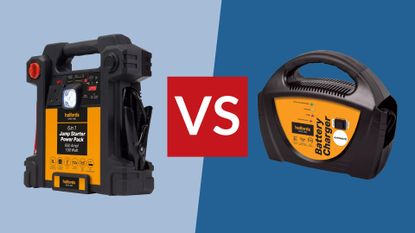When it comes to helping a car with a dead battery, there are two approaches to take – a portable jump starter or a battery charger. Both of these products bring your battery (and car) back to life by feeding energy back into a dead battery. But they work in different ways and while it may seem trivial it is important to understand their differences before buying the best jump starter, or the best battery charger.
Why has your car battery died?
As a quick aside, if your battery has died then this is usually because the car has been left unused for quite a long time; if the battery has died more quickly than expected, then your car potentially has a faulty battery or alternator, which charges the battery while you drive. Regularly charging the battery will keep your car running, but if you think it is quickly losing charge then there’s a problem elsewhere that needs addressing.
You may also be interested in buying a trickle charger, which plugs into a wall outlet and feeds energy into the car battery very slowly. If you park your car in a garage for extended periods of time, these are a good way to keep the battery full without causing damage through overcharging.
Pros and cons of a battery charger:
First, we’ll start with the battery charger. As the name suggests, this works a lot like any other charger you have at home. It plugs into a wall outlet and connects to your car battery to charge it back up after it has died.
They work by feeding energy back into the battery. But due to the size of car batteries, this can take some time. Where your phone can fill up in a couple of hours, a car battery can take between 10 and 24 hours to refill from empty. Generally speaking, between two and four hours of charging is required to give a dead battery enough energy to start a car.
Generally speaking, more powerful chargers capable of filling the battery more quickly cost more money, but can be larger and heavier as a result. That said, this is a product that is likely to live in your garage and not be hauled around in the car, so size shouldn’t be a major factor.
Battery chargers tend to cost in the region of £20 / $20 to £70 / $70, while some can cost over £100 / $100; a higher amperage means a quicker charge time, and therefore carries a higher price.
Because battery chargers need to connect to both the battery and a wall outlet, you’ll need to have a garage with a plug socket within reach of the car, or remove the battery and bring it inside to plug it in. The advantage of a charger over a jump starter is how you know it is giving the battery a full charge, and once filled the battery will start your car repeatedly and reliably. However, if the battery does eventually die again due to a fault elsewhere, then the charger can’t be relied upon to start your car instantly.
Pros and cons of a jump starter:
On the other hand, we have battery jump starters. These have their own integrated battery, tend to be more portable than chargers, and can deliver enough power to instantly start your car if its own battery is flat. These do not charge the battery back up, but once the car is started its alternator will feed energy back into the battery (unless there is a pre-existing fault with the alternator or battery, of course).
Jump starters have shrunk in size over the last decade or so, and have gained additional features like integrated LED torches and connections for charging devices like smartphones, tablets and laptops.
As such, these act as large but portable power banks that can also start your car. As for their portability, some of the smallest models are almost pocket-sized and many can fit in your car’s glove box, meaning they are always ready to be deployed if your car won’t start. That said, their compact size means they can only start a car (or attempt to start a car) a handful of times before their battery needs charging. You’ll need to keep an eye on the charge level of your jump starter and remember to charge it from a wall socket every few uses.
The main advantage of a jump starter over a battery charger is time-saving, as a jump starter immediately starts your car and gets you on your way, whereas the charger needs a few hours before you can even think of turning the key.
Jump starters tend to be more expensive than battery chargers, with prices varying from around £50 / $50 to £150 / $150, with some examples costing as much as £200 / $200 or even £300 / $300.
A higher price generally means a larger, more powerful battery that is capable of starting a larger vehicle (measured by engine capacity). Many modern jump starters resemble large power banks, while some are much bigger and have an integrated carry handle, making them less practical to carry in a smaller vehicle.
Now take your new-found knowledge to buy the best jump starter around, and learn how to jump start your car using a jump starter.
Liked this?
- Best dash cam: top car dash cams tried and tested
- Cheap dash cam deals
- Best sat navs
- Best car seat



